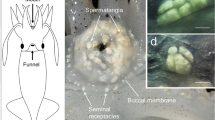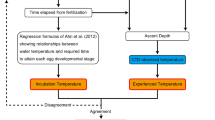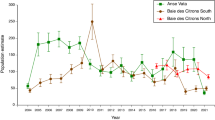Abstract
IN 19341 and 19352, as a result of field observations and a statistical investigation of variation in the spawning date of the common frog, Rana temporaria, I showed that the observed relations were very unlike what would be expected if the weather were acting directly on the frogs, and suggested that the weather acted on the algae of the ponds. In 19613 a more extensive investigation lent support to this conclusion.
This is a preview of subscription content, access via your institution
Access options
Subscribe to this journal
Receive 51 print issues and online access
$199.00 per year
only $3.90 per issue
Buy this article
- Purchase on Springer Link
- Instant access to full article PDF
Prices may be subject to local taxes which are calculated during checkout
Similar content being viewed by others
References
Savage, R. M., Nature, 133, 216 (1934).
Savage, R. M., Proc. Zool. Soc. Lond., 49 (1935).
Savage, R. M., The Ecology and Life History of the Common Frog (Pitman, London, 1961).
Fisher, R. A., and Yates, F., Statistical Tables (Oliver and Boyd, Edinburgh, 1948).
Bles, E., Trans. Roy. Soc. Edin., 41, 789 (1906).
Vanderplank, F. L., The Aquarist, 9, 183 (1939).
Grimm, H., Zeitschr. Tierpsychol., 9, 230 (1952).
Author information
Authors and Affiliations
Rights and permissions
About this article
Cite this article
SAVAGE, R. External Stimulus for the Natural Spawning of Xenopus laevis. Nature 205, 618–619 (1965). https://doi.org/10.1038/205618a0
Issue Date:
DOI: https://doi.org/10.1038/205618a0
This article is cited by
-
Stimulation of Spawning in Xenopus laevis by Fowl Manure
Nature (1966)
Comments
By submitting a comment you agree to abide by our Terms and Community Guidelines. If you find something abusive or that does not comply with our terms or guidelines please flag it as inappropriate.



